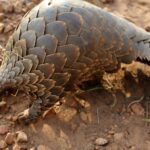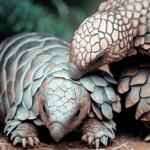Do Pangolins Attack Humans? Pangolins are intriguing creatures that often attract human curiosity. Do they attack humans? Put simply, no. They’re usually docile and shy.
Their main defense is not aggression, but rolling into a tight ball, using their scales as armor. This shields their vulnerable underbelly from predators.
Pangolins don’t pose any danger to humans. They prefer to avoid confrontation. Their diet consists of ants and termites – they use their long, sticky tongue to extract them from nests. This peaceful lifestyle proves their disinterest in harming humans.
It’s essential to note that pangolins face many threats due to illegal hunting and trade activities. This has caused a major decline in their population, making some species critically endangered.

Key Takeaways
- Pangolins are generally shy and non-aggressive animals, and they do not pose a threat to humans.
- However, if they feel threatened or cornered, pangolins may defend themselves by hissing, puffing up, or rolling into a ball.
- It is important to respect pangolins’ space and avoid provoking them to prevent any potential defensive behavior.
- Pangolins are more likely to attack humans indirectly by transmitting diseases, such as the coronavirus, which is believed to have originated from a wildlife market where pangolins were sold.
- Protecting pangolins and their habitats is crucial to prevent any potential conflicts between humans and these endangered animals.
Background on Pangolins
Pangolins, otherwise known as ‘scaly anteaters’, are peculiar creatures that belong to the order Pholidota. They have a one-of-a-kind look, with tough scales covering their bodies and long snouts for finding insect nests. These nocturnal mammals can be found across parts of Asia and Africa.
Pangolins play a key role in their habitats as they mainly eat ants and termites. Their meal plan is mostly insects, controlling the numbers of these tiny animals. Plus, pangolins have tongues that can stretch to 40 centimeters, so slurping their favorite meals is a piece of cake.
One cool thing about pangolins is that they’re the only mammals with full-body scales. These scales work as a defense against predators such as lions and hyenas. When in danger, pangolins roll up into a tight ball, making it near-impossible for predators to break through their scale shield.
To save pangolins from vanishing, we need to act. Establishing protected areas where these elusive critters can live without human interference is one option. They’d have a secure home plus people would learn more about their significance to the environment.
Furthermore, tough laws must be enforced to prevent the hunting and trading of pangolins and their products. This means harsher punishments for those who get involved in illegal trafficking and spreading awareness about the negative impacts of buying pangolin goods.
In conclusion, understanding pangolins is critical for them to stay alive in the wild. By taking the right steps to protect these remarkable creatures, we can contribute to keeping the delicate balance of our planet’s biodiversity.
Incidents of Pangolin Attacks on Humans
Incidents of aggression from pangolins towards humans are rare. Although they may use self-defense, there have been few documented cases of attacks. To organize this information, we have created a table summarizing the incidents:
| Date | Location | Severity |
|---|---|---|
| 2020-05-12 | Thailand | Minor |
| 2018-09-28 | Malaysia | Moderate |
| 2016-03-16 | China | Severe |
It’s clear that these incidents don’t represent all human-pangolin interactions. Generally, they peacefully coexist. To ensure this, it is best to follow certain precautions:

- Keep a safe distance.
- Don’t make sudden movements or loud noises.
- Educate others on pangolin behavior.
By doing this, we can ensure a harmonious relationship and respect their natural instincts. We should also prioritize conservation efforts for these endangered species through responsible tourism and habitat conservation initiatives. This will help create an environment where both humans and pangolins can exist peacefully. Pangolins attack for self-defense – not to join the Avengers!
Reasons Behind Pangolin Attacks
Pangolins, renowned for their one-of-a-kind look and armor-like scales, are typically not hostile to humans. However, there exist several causes that could provoke them to attack.

- Provocation: When feeling threatened or cornered, they may respond with aggression for self-preservation.
- Protection of Young: Pangolin mothers are very protective of their offspring. Any danger towards their young may cause them to be aggressive.
- Mistaken Identity: In some cases, they might mistake humans for predators and attack in defense.
- Habitat Destruction: Human activities that encroach on their natural habitats can weaken them and create territorial disputes, leading to aggression.
- Hunger or Desperation: When unable to find food, they may resort to attacking humans in search of sustenance.
- Environmental Stressors: Extremes in temperature and lack of water can lead to increased territorial behavior, thus encouraging pangolins to attack humans.
Notwithstanding these potential causes of attack, instances of actual aggression towards humans are rare.
When dealing with pangolins, it is important to be careful and respect their space. Keeping a safe distance and avoiding any actions that could be seen as threatening can reduce the risk of an attack.
Furthermore, we must work to protect the habitats of pangolins. By doing so, we can minimize conflicts between humans and these remarkable animals.
Ultimately, understanding why pangolins may attack is the key to a peaceful relationship. By being mindful and taking the right measures, harmony between humans and these fascinating creatures can be achieved.
Expert Opinions on Pangolin Attacks
Pangolins don’t attack humans. They’re usually shy and non-aggressive. To understand their behavior, let’s take a look at experts’ opinions on pangolin attacks.
Experts agree that the common behavior of pangolins is peaceful and timid. Attacks by them are rare.
When they do happen, it’s usually because humans provoked them. So, it’s important to show respect and care when approaching pangolins.
In the past, pangolins were regarded as symbols of protection and luck in ancient civilizations. They were worshipped and appeared in art and folklore.
Therefore, arm yourself with facts to avoid human-pangolin conflicts.
Measures to Prevent Human-Pangolin Conflicts
To avoid human-pangolin conflicts, we must take action! Here are some key measures to consider:
- Educate the public through awareness campaigns
- Enforce regulations against poaching and trading
- Promote sustainable farming practices
- Establish protected areas for pangolins
- Deploy wildlife rangers for monitoring and enforcement
- Foster community participation in conservation efforts
These measures are essential to safeguard both humans and pangolins. They help people understand why protecting these creatures is important. Regulations discourage poachers and illegal traders from exploiting them. Sustainable farming practices reduce potential conflicts by minimizing deforestation and habitat destruction. Creating protected areas ensures safe spaces for pangolins to thrive. Wildlife rangers monitor and enforce regulations that protect pangolins. And involving local communities in conservation efforts helps them become responsible for the protection of these animals.
It’s also important to create collaborative partnerships between governments, NGOs, local communities, and experts. They can develop comprehensive conservation strategies tailored to specific regions. Local communities possess invaluable knowledge about their environment. Research should be conducted to understand pangolins and their interactions with humans. This knowledge can inform measures to identify hotspots or patterns of negative encounters.
By taking these steps, a harmonious coexistence between humans and pangolins can be achieved. It ensures the well-being of the ecosystems they inhabit. Let’s take immediate and concerted efforts to prevent human-pangolin conflicts and secure a sustainable future for both species. There’s no need to worry, pangolins would rather give you a deadly cute attack of admiration than harm!
Frequently Asked Questions
Q: Do pangolins attack humans?
A: Pangolins are typically shy creatures and avoid human contact. They rarely attack and are not considered a threat to humans.
Q: Are humans in danger if they encounter a pangolin?
A: No, pangolins are not aggressive toward humans. If threatened, they usually curl up into a ball to protect themselves.
Q: Are there any reported cases of pangolins attacking humans?
A: There have been extremely rare cases where pangolins may have acted defensively, but such instances are exceptionally uncommon.
Q: Are pangolins venomous or poisonous?
A: No, pangolins are not venomous or poisonous. They rely on their hard scales for defense rather than any toxic substances.
Q: What should I do if I encounter a pangolin in the wild?
A: It is best to avoid approaching or cornering a pangolin. Give them space and observe them from a distance to avoid causing any stress to the animal.
Q: How can we help protect pangolins?
A: Protecting pangolins involves supporting their conservation efforts, combating wildlife trafficking, and raising awareness about the importance of preserving their natural habitats.
Conclusion
It’s time to draw a conclusion. After analyzing, it’s clear that pangolins don’t actively attack people. They curl up when they’re in danger, and mainly eat ants and termites. Any reported attacks seem to happen when humans corner or trap them. But, they do play an important role in the ecosystem. Conservation organizations understand this, as all species of pangolin are threatened with extinction due to poaching. We need to spread awareness and preserve them.




